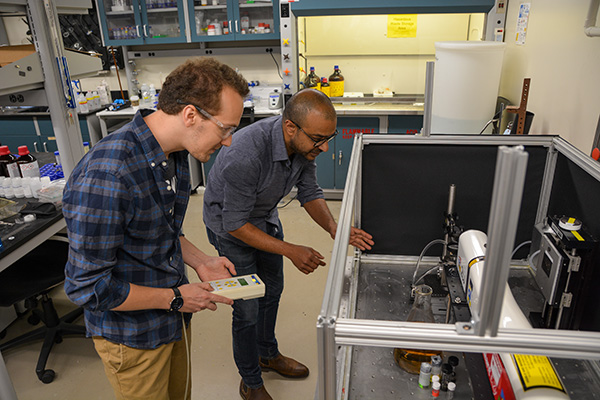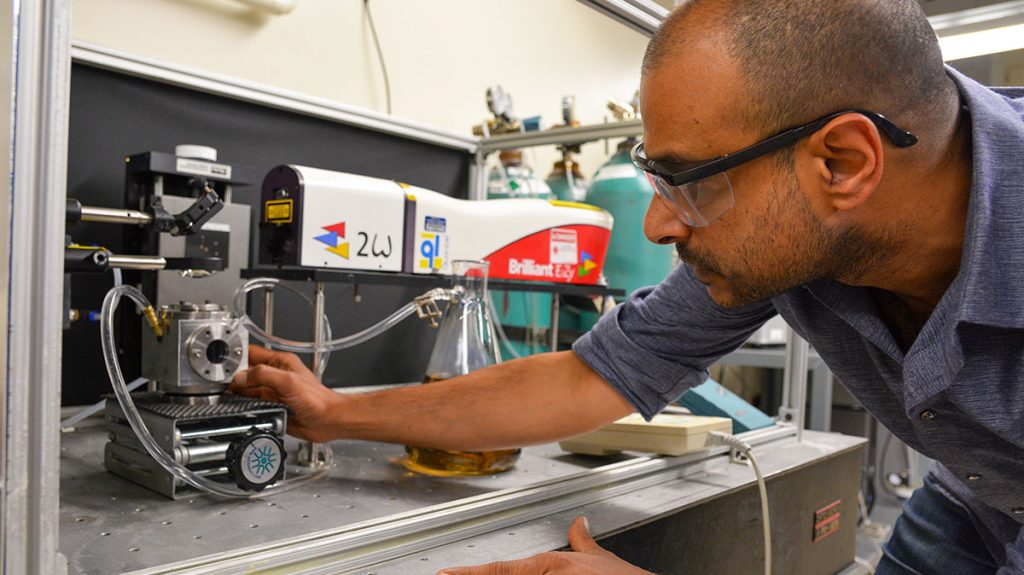By David Goddard. Photograph by Yvette Gooden.
Small changes in design, manufacturing techniques, and production can sometimes lead to big differences in a final product, as is the case with energetic nanomaterials, or ENMs.
ENMs belong to the class of high-energy density materials synthesized with tailor-made specifications to increase their stability and energy release effects. Such materials are relevant to a wide range of applications, from explosives for munitions and solid propellants for recently privatized space missions to automobile air bags.
The problem with existing ENMs has been getting the right combination to maximize their effectiveness—especially their ability to be stored for a long duration and quickly deployed when required. It has so far proven to be an elusive grand challenge–level problem in the energetic materials community.
That’s where CBE Research Assistant Professor Dibyendu Mukherjee and his lab group members, doctoral student Elijah Davis and postdoctoral research associate Ravi Pamu, come in.
Mukherjee has proposed a new method of developing ENMs through the use of large-scale nanomanufacturing driven by machine learning and, perhaps more importantly, a process called programmable laser ablation synthesis in solution, or Pro-LASiS. It uses high-energy pulsed laser technology to create liquid-confined plasmas with tunable laser energies that help design materials with the desired size, shape, structures and—especially challenging—metastability at the nanoscale level.

“We are proposing to upgrade our current LASiS technology to allow us to go from our current benchtop setup to a data-driven programmable LASiS technique that can enable cost-effective and large-scale machine-learning-driven nanomanufacturing,” said Mukherjee. “Our proposed pro-LASiS technique will offer the enabling technology to design and synthesize high-performance ENMs with accurate control on their structure–property relations while increasing production. Specifically, machine-learning-driven inoperando data analytics will provide real-time feedbacks to our synthesis routes that will allow us to gain more precision on structure–composition properties of the materials. This, in turn, affect the kinetics and thermodynamics of their energy release process.”
Mukherjee’s proposal garnered his research team a prestigious Defense University Research Instrumentation Program (DURIP) award from the US Department of Defense, as the work will have impact on a variety of materials it uses. The Air Force Office of Scientific Research is providing nearly $435,000.
The project is a spinoff from his 2017 efforts to develop a LASiS-GRR (Laser Ablation Synthesis in Solution–Galvanic Replacement Reactions) technique for the synthesis of functional intermetallic nanomaterials—work that earned him a US patent (Pat. No.: US 10,326,146 B2) and, despite its success, led him to think about critical improvements.
“We realized that our results were great when viewed on their own, but considerable challenges remain in terms of their production time, real-time quality control, and fundamental understanding on how internal structure and uniquely designed metastable states can affect the functioning of next-generation ENMs in terms of rate and amount of energy release,” said Mukherjee. “Such challenges are the critical bottlenecks that needed to be solved to cater to US defenses’ science and technology missions in the future. That’s why we wanted to address the large-scale manufacturability of future composite ENMs with tunable energetic activities, which led to our selection for the FY2021 DURIP award.”
Eventually such high-payoff-enabling technologies will provide a paradigm shift for the development of composite ENMs with exotic metastable structures for state-of-the-art US defense missions, offering the US Air Force long-term tactical and asymmetric advantages over near-peer adversaries in weapons and munitions development.
